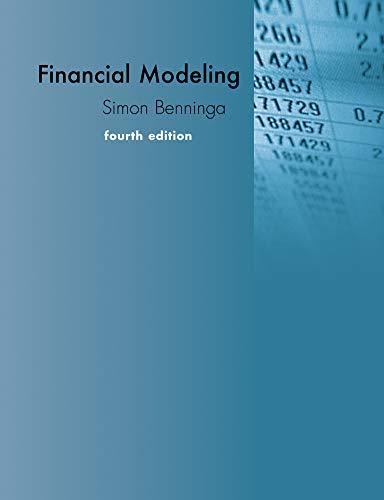Question
Continuing Value, Cost of Capital, and Moving from Enterprise Value to Value per Share Bo Corp. expects NOPLAT of $2,500,000 in the first year after
Continuing Value, Cost of Capital, and Moving from Enterprise Value to Value per Share
Bo Corp. expects NOPLAT of $2,500,000 in the first year after the forecast period (or the first year of continuing value period.In addition Bo expects growth of 3% during the continuing value period, return on new invested capital of 10%, and a weighted average cost of capital of 6%.Using the formula on page 260 of the text, please calculate the continuing value for Bo Corporation.
Go Corp. expects free cash flows of $1,000,000, $1,100,000, $1,200,000, $1,300,000, $1,400,000, in years 1,2 3,4, 5 respectively.In addition, Go has a continuing value of $2,500,000 at the end of year 5 and a cost of capital of 9%.Assuming year end cash flows, please open an excel spreadsheet enter the numbers above (in year 5 - you will have to sum the cash flow and the continuing value).Then use the NPV function to bring these yearly cash flow totals to present using the weighted average cost of capital as the discount rate. The enterprise value for Go Corp is _______________.
Lo Corp. has an enterprise value of $8,000,000, long term debt of $2,000,000, and an under-funded pension obligation of $1,800,000.If Lo has 60,000 shares outstanding (and no shares under option), please compute Lo's intrinsic value per common share.
Assume the same information as the prior problem.In addition, Lo Corp. has 40,000 shares under option and "in the money".Please use the denominator method or exercise value approach on pages 333-334 in the book, and assume that all 40,000 option will be exercise (with no proceeds - because future grants will offset any proceeds).What is the new intrinsic value per common share?
Coe Corp. has a cost of equity of 15%, and an after tax cost of debt of 8%.Using market values Co's debt is 45% of the value of the firm and Co's equity is 55% of the value of the firm.What is Coe Corp. weighted average cost of capital?
Doe Corp. can borrow at 14% and is has a 40% marginal tax rate. What is Doe's after tax cost of debt?
Foe Corporation has a beta of 1.4, the expected return on a market portfolio is 8.7% and the risk free rate is expected to be 3.7% (so the market risk premium is expected to be 5%).Using the Capital Asset Pricing Model (on page 293 in the textbook), what is Foe's after tax cost of equity?
Why is it not necessary to adjust for taxes in question 7 (like we did in question 6)?
Step by Step Solution
There are 3 Steps involved in it
Step: 1

Get Instant Access to Expert-Tailored Solutions
See step-by-step solutions with expert insights and AI powered tools for academic success
Step: 2

Step: 3

Ace Your Homework with AI
Get the answers you need in no time with our AI-driven, step-by-step assistance
Get Started


